June 13, 2011 – 09:10 am EDT
The market continued its slide over the last week and there was nothing pretty about it. Lets take a closer look…
.
ETF % Change Comparison
.

Those are some ugly stats! IWM just made a lower low and saw the biggest declines for the week while DIA saw the least. This shows that investors are retreating to safety and reconfirms that the declines need to be taken seriously.
Learn more – ETF % Change Comparison
.
![]()
.
A Look at the Charts
.
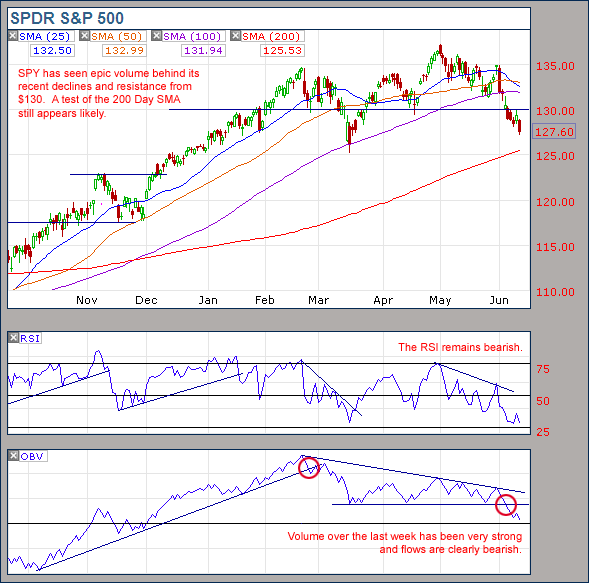
The sudden surge of volume on SPY behind the recent declines is very bearish.
.
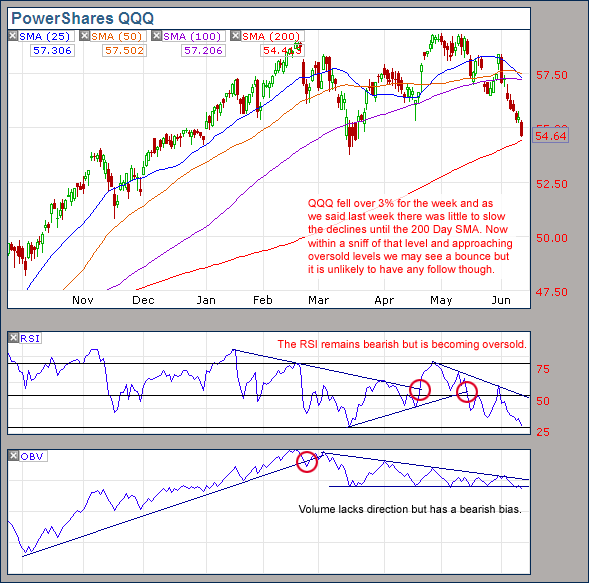
With QQQ right by support I would expect to see some buying interest soon.
.
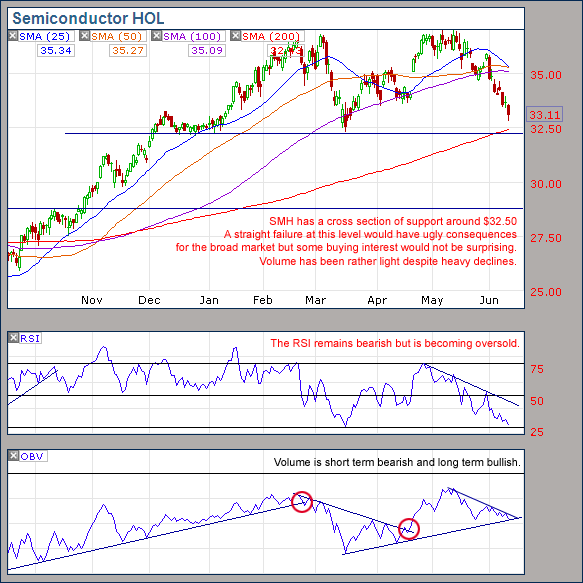
SMH has epic support around $32.50 so keep an eye on this important level.
.
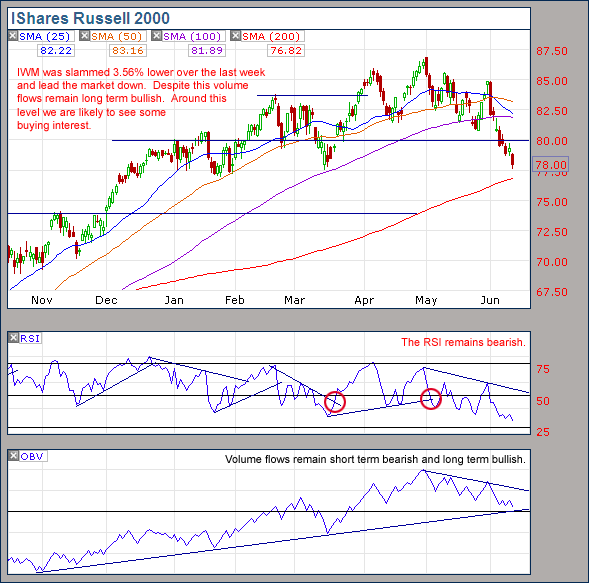
IWM is right on its March low so further declines from here will do major technical damage.
.
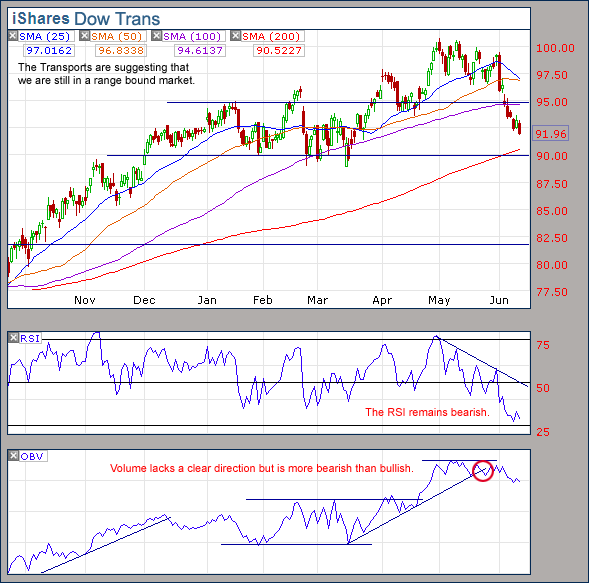
The transports again lack direction.
.
![]()
.
OM3 Weekly Indicator
.

The OM3 Indicator remains bearish across the board.
Learn more – The OM3 Indicator
.
![]()
.
TransDow & NasDow
.

TransDow – The Dow is dominant over the Transports and the TransDow remains in cash.
NasDow – The NasDow has moved to cash and is showing no signal or no dominant index.
.
What the TransDow Readings tell us:
The TransDow measures dominance between the DJ Transportation Index (DJTI) and the Dow Jones Industrial Average (DJIA). In a strong market the more economically sensitive Transportation Index should be dominant over the DJIA.
Historically the DJTI has been dominant over the Dow 45% of the time. The annualized rate of return from the DJTI during this period was 18.47% with the biggest loss for one trade sitting at -13.27%. The annualized return from the DJIA during the periods it was dominant over the DJTI was just 4.06% and the biggest loss for one trade was -16.13%. A 4% stop-loss is applied to all trades adjusting positions only at the end of the week.
What the NasDow Readings tell us:
The NasDow measures dominance between the NASDAQ and the DJIA. Using the same theory behind the Trans Dow; in a strong market the more economically sensitive NASDAQ should be dominant over the DJIA.
Historically the NASDAQ has been dominant over the DJIA 44% of the time. Taking only the trades when the NASDAQ is above its 40 week moving average the annualized rate of return was 25.47% with the biggest loss for one trade sitting at –8.59%. The annualized rate on the DJIA during the periods it was dominant over the NASDAQ is just 8.88% and the biggest loss for one trade was –12.28%. A 8% stop-loss is applied to all trades adjusting positions only at the end of the week.
.
![]()
.
LTMF 80 & Liquid Q
.
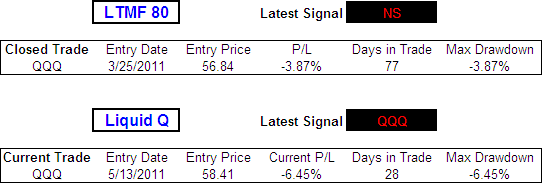
LTMF 80 has moved to cash and locked in a loss of 3.87% after 77 days. Liquid Q continues to endure a position in QQQ that is starting to show a rather unpleasant loss.
.
Historical Stats:
.

.
How The LTMF 80 Works
LTMF stands for Long Term Market Forecaster. It reads volume flows relative to price action and looks for out performance of volume measured on a percentage basis over the prior 12 months. During a sustained rally the readings will reach high levels (near 100%) making it imposable for the volume reading to always outperform price so any reading above 80% will maintain the buy signal. This system has outperformed the market over the last 10 years but performance has been damaged by some nasty losses. It only produces buy signals and only for QQQ.
How Liquid Q Works
Liquid Q completely ignores price action and instead measures the relative flow of money between a selection of economically sensitive and comparatively stable ares of the market. It looks for times when the smart money is confident and and can be seen by through volume investing heavily is more risky areas due to an expectation of expansion. This system has outperformed the market over the last 10 years and remained in cash through most of the major declines. It only produces buy signals and only for QQQ. We will provide more performance details on the web site for these systems soon.
.
![]()
.
Summary
The declines over the last two weeks have been sharp and substantial. Now with some oversold readings developing, multiple encounters with the 200 Day SMA coming up along with several other support levels, it is time for some buying interest from the bulls. If these multiple and substantial support levels can’t even slow the declines then I will be very surprised. However with the technical damage already done the best case scenario is a range bound market.
Any disputes, questions, queries, comments or theories are most welcome in the comments section below.
.
Cheers
Derry
And the Team @ ETF HQ
“Equipping you to win on Wall St so that you can reach your financial goals.”
.
![]()
.
Quote of the Day
“Don’t tell me it’s impossible, tell me you can’t do it. Tell me it’s never been done. The only things we really know are Maxwell’s equations, the three laws of Newton, the two postulates of relativity, and the periodic table. That’s all we know that’s true. All the rest are man’s laws…” – Dean Kamen
.
.
Derry,
In my opinion, history is about to repeat it’s self. In my opinion, it is 1930 all over again…. When the market rallied back in 1930, it stopped at about 78% of the losses of the 1929 crash. Then the market really fell. When the market finally bottomed in 1934 (about four months after the introduction of the Glass-Steagall Act) it was selling at roughly 10% of the 1929 highs…… May 2nd, (when the June 30th end of QE-2 was announced) just happened to be roughly, the 78% recovery of the March 2009 bottom. The Glass-Steagall Act was removed in 1999 and that allowed the highly leveraged and highly risky SIV’s and CDO’s which, in my opinion, brought the financial meltdown of 2007…… This kind of financial behavior was very similar to the kind of highly leveraged and highly risky trading behavior which caused the crash in 1929. That kind of financial behavior was made illegal after the imposition of G.S…… And incidentally, G.S. still has not been reintroduced, despite the crash of October 2007 until March 2007, when the government vainly stepped in to try to halt the meltdown……. The Accumulation/Distribution charts show that the institutions are selling, despite the daily 6-8 billion that QE-2 is bringing…..
Mike
Hopefully, your readers will recognize that I was referring to the March 2009 bottom, which came as the government began QE-1….
Selfishly it would be a fun market to ride although if you are right Mike, the devastation for most people would be incredibly painful. You have got to love this business.
Derry
Incredibly painful, but classic Kondrotiev economic cycle theory in play…… He preached that every 40-60 years (that needs to be lengthened to 70 years as people are living longer now than in 1923 when he published his theories) the ultra wealthy conservatives take over media and convince the people that their way is right. Then when elected they remove the financial safeguards in the name of short term profits and in the end crash the market, are thrown out of office and the cycle begins all over again….. Then the liberals take command, return the regulations and the standard of living and the economic expansion returns and all is well for about 70 years until those that suffered have died and the story has gone cold….. Then again they come…..